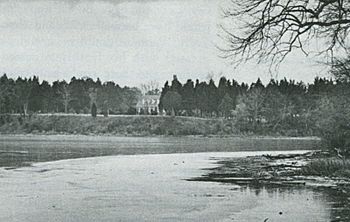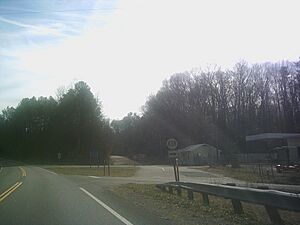Popes Creek (Virginia) facts for kids
Quick facts for kids Pope's Creek |
|
|---|---|

The waters of Pope's Creek from across the cove showing the 20th century Memorial House
|
|
| Country | United States |
| State | Virginia |
| County | Westmoreland County |
| Physical characteristics | |
| River mouth | Potomac River 0 feet (0 m) |
| Length | 5.3 miles (8.5 km) |
Pope's Creek is a small, 5.3-mile-long (8.5 km) waterway in Westmoreland County, Virginia. It's a tributary (a smaller stream that flows into a larger one) of the mighty Potomac River. What makes Pope's Creek special is that the George Washington Birthplace National Monument is located right along its northern side. This means the first President of the United States grew up near these waters!
Contents
Different Names for Pope's Creek
Like many old places, Pope's Creek has been known by a few different names over time. The United States Geological Survey has recorded these other names:
- Cedar Creek
- Cedar Island Creek
- Fishing Creek
- Mister Pope's Creek
- Pope Creek
- Pope's Creek
The Creek's Environment
Pope's Creek is a tidal creek, meaning its water levels change with the ocean's tides. The mouth of the creek has a "flood-tide delta." This is like a natural trap for mud and dirt carried by the water. It also collects extra nutrients from nearby farms.
The land around the creek has changed over hundreds of years. Farmers have shaped the land, and erosion from the Potomac River also adds to the sediment. You can even find old tree stumps from the 1600s buried under two meters of farm soil!
Water Flow and Depth
Beaver dams and old mill ponds can be found along the creek. These structures can slow down the water's flow. Historically, only small boats could travel on the creek. Today, it's usually about one meter deep, plus an extra 0.3 to 0.4 meters from the tide.
The creek is slowly getting shallower as sea levels rise. This pushes silt (fine sand or clay) from the Potomac River further inland. Scientists have drilled into the creek bed and found about 15 meters of sediment. This sediment contains mollusk shells and dates back over 6,000 years!
Amazing Aquatic Life
Pope's Creek has always been a great place for fishing. People have been gathering oysters here for thousands of years. Archeologists found ancient shell piles (called middens) from Native Americans. Even in the 1700s, George Washington's family ate a lot of oysters from the creek.
When Captain John Smith explored the area, he wrote about how many fish there were. He said the fish were so thick that their heads stuck out of the water! His men even tried to catch them with a frying pan. During spring, smaller parts of the creek would get packed with fish like shad. Later, colonial records show that people used fishing nets to catch local fish like white perch.
Fish Kills and Algal Blooms
Sometimes, the creek experiences problems. In the summer of 2007, many fish died in Pope's Creek and nearby areas. This was caused by an algal bloom. Algae are tiny plant-like organisms. When too many grow, they can create toxins or use up all the oxygen in the water.
This particular bloom was caused by a type of algae called Karlodinium. It made the water a reddish-brown color. Hundreds of thousands of fish died, including menhaden, white perch, and croaker. Other affected species included gizzard shad, mummichog, channel catfish, American eel, hogchoker, largemouth bass, and even blue crabs.


